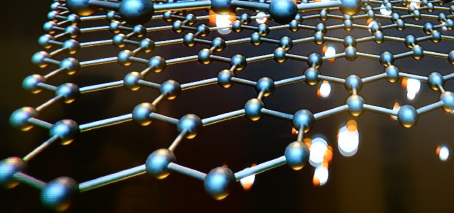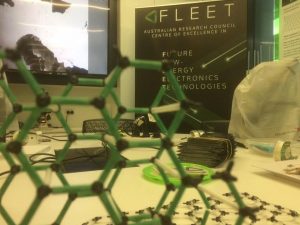Why does FLEET use atomically-thin, 2D materials?
FLEET uses materials that are just one layer of atoms in thickness, referred to as being ‘atomically thin.’ Such materials are also known as ‘two dimensional’ (2D), as opposed to three dimensional.
Quantum effects become much more significant when the freedom of charge carriers is restricted to only two dimensions (relative to their de Broglie wavelength).
The most famous 2D material is graphene, which has remarkable electronic and physical properties. For example, electron speed in graphene is almost a hundred times faster than in copper.
FLEET also pursues other 2D materials with the particular properties necessary for ultra-low energy electronics. For example:
 FLEET’s Research theme 1 studies 2D topological insulators with one-dimensional, one-way conducting channels along their edges. Because quantum physics prevents charge carriers from moving ‘backwards’ along these edge channels, there is no back-scattering, and thus no wasted dissipation of energy. For the purposes of topological insulators, a material is 2D when there isn’t sufficient energy available to propel electrons out of the 2D plane. For topological function at room temperature (where more energy is available than at supercooled temperatures), the material must be very thin – typically one or a few atoms thick, so atomically thin van der Waals materials are desired.
FLEET’s Research theme 1 studies 2D topological insulators with one-dimensional, one-way conducting channels along their edges. Because quantum physics prevents charge carriers from moving ‘backwards’ along these edge channels, there is no back-scattering, and thus no wasted dissipation of energy. For the purposes of topological insulators, a material is 2D when there isn’t sufficient energy available to propel electrons out of the 2D plane. For topological function at room temperature (where more energy is available than at supercooled temperatures), the material must be very thin – typically one or a few atoms thick, so atomically thin van der Waals materials are desired.
 FLEET’s Research theme 2 pursues exciton superfluids at room temperature. Room-temperature condensation requires both that the electron and hole bind strongly to form an exciton, and that excitons interact strongly with each other – both interactions occur through the electric force. In order to maximise these interactions, electrons and holes, and other excitons, must be close to each other, and the strength of the electric force must be maximised by reducing the dielectric constant. 2D materials help in both ways: they bring the electrons and holes very close to each other, and the material can be encased in low-dielectric constant cladding which maximises the electric force.
FLEET’s Research theme 2 pursues exciton superfluids at room temperature. Room-temperature condensation requires both that the electron and hole bind strongly to form an exciton, and that excitons interact strongly with each other – both interactions occur through the electric force. In order to maximise these interactions, electrons and holes, and other excitons, must be close to each other, and the strength of the electric force must be maximised by reducing the dielectric constant. 2D materials help in both ways: they bring the electrons and holes very close to each other, and the material can be encased in low-dielectric constant cladding which maximises the electric force.
 FLEET’s Research theme 3 Atomically-thin, 2D materials will play a key enabling role in realising the Floquet topological insulator. 2D semiconductors allow a strong light field of uniform intensity over the entire sample with minimal absorption of the light (this is not possible in 3D due to the finite penetration of light into the sample). 2D materials also have potential for the realisation of 1D chiral edge modes. As a result, FLEET’s research on Floquet topological states is entirely on 2D systems.
FLEET’s Research theme 3 Atomically-thin, 2D materials will play a key enabling role in realising the Floquet topological insulator. 2D semiconductors allow a strong light field of uniform intensity over the entire sample with minimal absorption of the light (this is not possible in 3D due to the finite penetration of light into the sample). 2D materials also have potential for the realisation of 1D chiral edge modes. As a result, FLEET’s research on Floquet topological states is entirely on 2D systems.
FLEET leverages previous, established expertise on atomically-thin 2D materials, for example FLEET Director Michael Fuhrer‘s graphene research at the University of Maryland, the Monash Centre for Atomically Thin Materials, Xiaolin Wang at the University of Wollongong, and Kourosh Kalantar-Zadeh at UNSW.
For more information
- Visit FLEET.org.au
- Connect @FLEETCentre
- Contact media@FLEET.org.au
- Watch Future solutions to computation energy use at FLEET
- Subscribe FLEET.org.au/news


